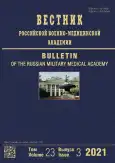Prospects for improving immunoprophylaxis of infectious diseases
- Authors: Stepanov A.V.1, Myasnikov V.A.1, Apcel V.Y.2,3
-
Affiliations:
- State Scientific-research Test Institute of Military Medicine
- Military Medical Academy named after S.M. Kirov of the Ministry of Defense of the Russian Federation
- A.I. Herzen Russian State Pedagogical University of the Ministry of Education and Science of the Russian Federation
- Issue: Vol 23, No 3 (2021)
- Pages: 189-194
- Section: Reviews
- URL: https://journals.rcsi.science/1682-7392/article/view/65107
- DOI: https://doi.org/10.17816/brmma65107
- ID: 65107
Cite item
Abstract
This study described the perspective and significance of using “complex vaccine systems” in improving immunoprophylaxis of major infectious diseases of various etiologies and genesis. Immunobiological drugs traditionally used for this purpose, along with the advantages, have disadvantages, such as increased reactogenicity and development of post-vaccine reactions and complications in some cases. Such adverse effects are serious obstacles to immunoprophylaxis on a mass scale. This circumstance was the reason for the improvement of immunoprophylaxis, and the main focus was the creation of chemical, recombinant, and subunit vaccines. However, compared with traditional drugs, these vaccines have inferior effectiveness, even if they are practically reactogenic and do not lead to the development of post-vaccine reactions and complications. The main approaches to the development of effective and safe methods of immunoprophylaxis are considered based on the development of “complex vaccine systems”, and the components can be protective antigens, biologically active substances of the corresponding microorganisms, adjuvants applied or embedded in the corresponding biologically active, and safe biotechnological platforms. Among the latter, nanoparticles and microparticles of polylactoglycolic acid, liposomes, lipids, and copolymers are recognized as the most suitable for the construction of “complex vaccine systems”. This paper highlighted new trends in the development of these methods of immunoprophylaxis and their advantages in comparison with traditionally used immunobiological drugs. Moreover, prospects are characterized and examples of developed vaccine preparations are presented. The mechanisms of action of postvaccination immunity and factors that influence its formation are described.
Full Text
##article.viewOnOriginalSite##About the authors
Alexander V. Stepanov
State Scientific-research Test Institute of Military Medicine
Author for correspondence.
Email: alexander_58@mail.ru
SPIN-code: 7279-7055
doctor of medical sciences, professor
Russian Federation, Saint-PetersburgVadim A. Myasnikov
State Scientific-research Test Institute of Military Medicine
Email: gniiivm_7@mil.ru
SPIN-code: 5084-2723
candidate of medical sciences
Russian Federation, Saint-PetersburgVasiliy Ya. Apcel
Military Medical Academy named after S.M. Kirov of the Ministry of Defense of the Russian Federation; A.I. Herzen Russian State Pedagogical University of the Ministry of Education and Science of the Russian Federation
Email: apchelvya@herzen.spb.ru
ORCID iD: 0000-0001-7658-4856
SPIN-code: 4978-0785
doctor of medical sciences, professor
Russian Federation, Saint Petersburg; Saint PetersburgReferences
- Fan Y, Sahdev P, Ochyl LJ, et al. Cationic liposome-hyaluronic acid hybrid nanoparticles for intranasal vaccination with subunit antigens. J Control Rel. 2015;208:121–129. doi: 10.1016/j.jconrel.2015.04.010
- Haughney SL, Ross, KA, Boggiatto PM, et al. Effect of nanovaccine chemistry on humoral immune response kinetics and maturation. Nanoscale. 2014;6:13770–13778. doi: 10.1039/c4nr03724c
- Irvine DJ, Hanson MC, Rakhra K, Tokatlian T. Synthetic Nanoparticles for Vaccines and Immunotherapy. Chem Rev. 2015;115(19):11109–11146. doi: 10.1021/acs.chemrev.5b00109
- Sahdev P, Ochyl LJ, Moon JJ. Biomaterials for nanoparticle vaccine delivery systems. Pharm. Res. 2014;31(10):2563–2582. doi: 10.1007/s11095-014-1419-y
- Kuai R. Lipid-based nanoparticles for vaccine applications. In: Jo H, Jun HW, Shin J, Lee SH, editors. Biomedical Engineering: Frontier Research and Converging Technologies. Springer; 2015. P. 177–197.
- Marasini N, Skwarczynski M, Toth I. Oral delivery of nanoparticle-based vaccines. Expert Rev. Vaccines. 2014;13(11):1361–1376. doi: 10.1586/14760584.2014.936852
- Yue H, Ma G. Polymeric micro/nanoparticles: Particle design and potential vaccine delivery applications. Vaccine. 2015;33(44): 5927–5936. doi: 10.1016/j.vaccine.2015.07.100
- Bento D, Staats HF, Borges O. Effect of particulate adjuvant on the anthrax protective antigen dose required for effective nasal vaccination. Vaccine. 2015;33(31):3609–3613. DOI: 0.1016/j.vaccine.2015.06.037
- Tao P, Mahalingam M, Zhu J, et al. A bacteriophage T4 nanoparticle-based dual vaccine against anthrax and plague. MBio. 2018;9(5):e01918-e01926. doi: 10.1128/mBio.01926-18
- Huang S, Li IH, Po-da Hong MY. Development of Yersinia pestis F1 antigen-loaded microspheres vaccine against plague. Int J Nanomedicine. 2014;9:813–822. doi: 10.2147/IJN.S56260
- Richard K, Mann BJ, Stocker L, et al. Novel catanionic surfactant vesicle vaccines protect against Francisella tularensis LVS and confer significant partial protection against F. tularensis Schu S4 strain. Clin Vaccine Immunol. 2014;21(2):212–226. doi: 10.1128/CVI.00738-13
- Afley P, Dohre SK, Prasad GB, et al. Prediction of T cell epitopes of Brucella abortus and evaluation of their protective role in mice. Appl Microbiol Biotechnol. 2015;99(18):7625–7637. doi: 10.1007/s00253-015-6787-7
- Singh D, Goel D, Bhatnagar R. Recombinant L7/L12 protein entrapping PLGA (poly lactide-co-glycolide) micro particles protect BALB/c mice against the virulent B. abortus 544 infection. Vaccine. 2015;33(24):2786–2792. doi: 10.1016/j.vaccine.2015.04.030
- Davitt CJH, Lavelle EC. Delivery strategies to enhance oral vaccination against enteric infections. Adv Drug Deliv Rev. 2015;9: 52–69. doi: 10.1016/j.addr.2015.03.007
- MacLennan CA, Martin LB, Micoli F. Vaccines against invasive Salmonella disease: current status and future directions. Hum Vaccin Immunother. 2014;10(6):1478–1493. doi: 10.4161/hv.29054
- Garcia-Angulo VA, Kalita A, Torres AG. Advances in the development of enterohemorrhagic Escherichia coli vaccines using murine models of infection. Vaccine. 2013;31(32):3229–3235. doi: 10.1016/j.vaccine.2013.05.013
- Gregory AE, Judy BM, Qazi O, et al. A gold nanoparticle-linked glycoconjugate vaccine against Burkholderia mallei. Nanomedicine. 2015;11(2):447–456. doi: 10.1016/j.nano.2014.08.005
- Johnson MM, Ainslie KM. Vaccines for the Prevention of Melioidosis and Glanders. Curr Trop Med Rep. 2017;4(3):136–145. doi: 10.1007/s40475-017-0121-7
- Li X, Aldayel AM, Cui Z. Aluminum hydroxide nanoparticles show a stronger vaccine adjuvant activity than traditional aluminum hydroxide microparticles. J Control Rel. 2014;173:148–157. doi: 10.1016/j.jconrel.2013.10.032
- Lebeda FJ, Adler M, Dembek ZF. Yesterday and Today: The Impact of research conducted at camp detrick on botulinum toxin. Mil Med. 2018;183(5–6):85–95. doi: 10.1093/milmed/usx047
- Logunov DY, Dolzhikova IV, Zubkova OV, et al. Safety and immunogenicity of an rad26 and rad5 vector-based heterologous prime-boost COVID-19 vaccine in two formulations: two open, non-randomised phase 1/2 studies from Russia. Lancet. 2020;396(10255):887–897. doi: 10.1016/S0140-6736(20)31866-3
Supplementary files








